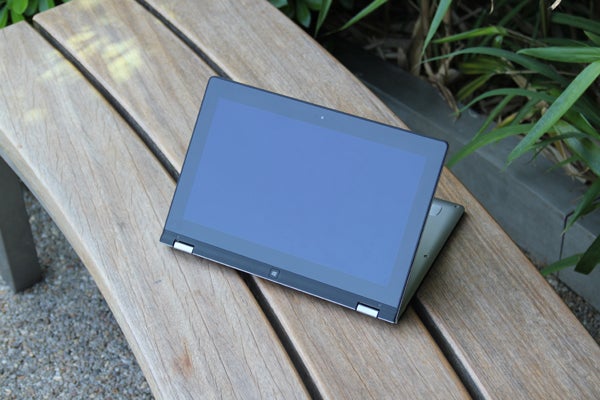Lenovo IdeaPad Yoga 11S Review
Lenovo IdeaPad Yoga 11S Review
One of the best Windows 8 laptop/tablet hybrids we've seen

Sections
- Page 1 Lenovo IdeaPad Yoga 11S Review
- Page 2 Performance, Heat & Noise and Battery Life Review
- Page 3 Keyboard, Touchpad and Verdict Review
Verdict
Pros
- Ultrabook and tablet in one
- Smart design and build quality
- Generous size SSD and 8GB of RAM
Cons
- Gets a little warm and noisy
- Touchpad is only so-so
- Battery a little too weak for all-day use
Key Specifications
- Review Price: £1099.00
- 11.6-inch 1366x768 touchscreen display; 1.4kg; Intel i7-3689Y 1.5GHZ processor; 8GB RAM; 256GB Solid State Drive; 360-degree hinged screen
What is the Lenovo IdeaPad Yoga 11S?
The Lenovo Ideapad Yoga 11S is an ultrabook, first and foremost. It’s a powerful one at that thanks to 8GB RAM and a generous 256GB of solid state storage, but the Yoga part of its name refers to the extra flexibility it offers. Like the larger 13-inch Lenovo IdeaPad Yoga 13, its screen flips a full 360 degrees to create a tablet – albeit one with a dormant keyboard and touchpad on its backplate.
As such, this is aimed at someone looking for something ultra-portable, who isn’t quite prepared to lose the keyboard completely, but is open to the flexibility a tablet provides. But how does it stack up in the real world?
Want a standard laptop? Read our best laptop round-up.

Lenovo IdeaPad Yoga 11S – Design & Build Quality
Lenovo has a reputation for distinct, stylish design and the IdeaPad Yoga 11S follows this tradition with a tasteful two-tone colour scheme. The outside has a chrome silver finish, while the inside has a very dark grey and black design. The keyboard side feels slightly rubberised, which is actually quite comfortable, but is presumably also designed with practicality in mind when this is the backplate of the device in ‘tablet mode’.
The screen itself moves to a glossy black colour scheme, with a second Windows Home button there too, so you’re never far away from the controls when you’ve parked the keyboard. The bezel is quite thick for a laptop, but looks like what we’ve come to expect from tablets.
Connectivity-wise, the IdeaPad keeps things simple: two USB ports, a headphone jack, an HDMI-out port, an SD card slot and the AC point. On top of that, there are a few extra buttons on the side: a volume control and a rotation-lock button, only available when held in tablet mode.

Lenovo Ideapad Yoga 11S – Screen Quality
As you’d hope with a device that wants to be a tablet as well as a laptop, the screen quality is, for the most part, excellent. The colour temperature, at 6595K is almost spot on (6500K is the ideal), and the contrast of 1059:1 is also pretty impressive. Icons appear sharp on the 11.6-inch screen, and day-to-day usage is a pleasure.
Two areas slightly let it down: firstly, the brightness isn’t very impressive at all; the peak brightness as measured using our Xrite i1 Display Pro is a distinctly average 202 nits, a long way short of the fantastically bright Sony Vaio Pro 13 that managed 372 nits at its brightest. This, combined with the glossy finish, means the Yoga 11S is difficult to use in bright light as the screen is very reflective and the it’s not bright enough to compensate.

The second weakness is that viewing angles are merely okay. The screen is just too reflective for angled viewing. Neither is too serious in a laptop, but in tablet mode when it’s designed for more use out-and-about these aren’t areas you want to be at all disappointed in.
On the bright side, as a touchscreen it works very nicely. It’s a 10 point touch interface, although on an 11.6-inch screen, you’ll struggle to get all 10 fingers on it at a time. As with all Windows 8 touchscreens, we have the usual issues: the big buttons on the start menu work well, but the desktop mode gets a bit fiddly.
How we test laptops
Unlike other sites, we test every laptop we review thoroughly over an extended period of time. We use industry standard tests to compare features properly. We’ll always tell you what we find. We never, ever, accept money to review a product.


